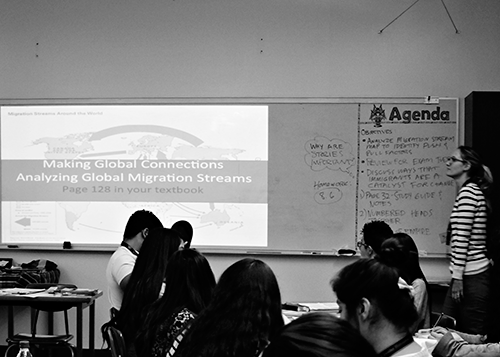Community schools are schools specifically set up to partner with other organizations to support students and families and improve student success. The Coalition of Community Schools define them as:
A community school is both a place and a set of partnerships between the school and other community resources. Its integrated focus on academics, health and social services, youth and community development and community engagement leads to improved student learning, stronger families and healthier communities. Community schools offer a personalized curriculum that emphasizes real-world learning and community problem-solving. Schools become centers of the community and are open to everyone – all day, every day, evenings and weekends.
While there are multiple models of community schools in place across the United States, the unifying theme among community schools is a comprehensive and integrated approach to student learning.
Community schools are also known as full-service schools, extended schools, Beacon schools, or community learning centers. Their history goes back to the late 1800s, but recently they are often found in urban settings where communities and educators are trying to close the social-economic gaps that face many urban students. Many universities have also become partners with local community schools and use this relationship for research, training, and outreach. Community schools have been proven to be effective at improving student success, motivation, and engagement.

and 2015 Extraordinary Achievement Award for Teacher Powered Schools,
Social Justice Humanitas Academy, CA
Teacher-Powered Community Schools
Community schools embrace a shared leadership model. While not “teacher-powered” in definition, the idea behind community schools is rooted in collective decision making not only by the teacher teams, but also students, parents and community members. This type of collaborative decision making is a fundamental characteristic of successful community schools.
Many teacher-powered schools are also community schools. The two overlap in many areas, but most importantly they are are both student-centered. When teacher teams have autonomy to design, implement, and make final decisions at their school sites, community schools naturally arise. Social Justice Humanitas Academy, supported by the Los Angeles Education Partnership, is an excellent teacher-powered community school example and the 2015 Award Winner for Excellence for Community Schools and the 2015 Extraordinary Achievement Award for Teacher Powered Schools.
Benefits to Being an Identified Community School/ Role of Coordinators
Teacher-powered schools that are also community schools have access to embedded, adaptive supports for students that often come from outside the school community. For example, they can access a coordinator (paid for by a different source of funding—not the school’s budget), who communicates academic and non-academic needs to community partners, who can provide services to the teachers and students.
Most teacher-powered schools currently have people on the teaching team addressing these needs, whose time could be freed up to work on other matters if they were in an identified community school setting. Community schools that are also teacher-powered schools find that when teacher teams have autonomy to make the decisions influencing school success, they can more quickly make the decisions needed to bring in community partners in support of students. These partnerships are most effective when teachers and partners work together to address the ever-changing needs of students, and this occurs naturally when teacher teams authorize and support the work of coordinators and partners, as they do in teacher-powered schools.
How to Become a Community School
The best place to start is the Coalition for Community Schools website under How to Start a Community School.
Union Support for Community Schools
Unions have shown open support for the community school model. Not only do community schools support students, they also create a better work environment for teachers by offering teachers more support services for their students. The NEA and AFT have, at the national, state, and local levels, supported community schools with resources aid teachers working at these schools.
State Community School Networks
Want to connect with your state community schools network? Email Mary Kingston Roche at rochem@iel.org and she can help connect you!
 NEWSLETTER SIGN-UP
NEWSLETTER SIGN-UP



